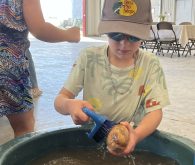After seven years and $2 million spent in research, a Saskatoon company known for pulse inoculants thinks it has developed a product for the next wave in crop protection – biological pesticides.
MicroBio RhizoGen Corp., or MBR, officially opened a new 30,000 sq.-foot plant here last week and introduced Nodulator, a clay-based granular legume inoculant.
President Murray Trapp said the company was created in 1987 just as pulse crop acreage in Western Canada was beginning to take off.
The company has grown in step with the pulse industry, here and around the world, and now ships to the United States, South America and Japan, in addition to the home market.
Read Also

Anti-separatist movement targets rural Alberta
Former deputy premier Thomas Lukaszuk’s anti-separatism Alberta Forever Canada petition campaign expects to run full steam ahead into the province’s farming regions
There is still room to grow as the pulse industry adds new crops such as chickpeas, he said. But MBR is also getting ready for the next wave of expansion as researchers come up with ways to solve pest and disease problems through biotechnology.
“We are working with Ag Canada and have a three-year agreement. Ag Canada is looking for delivery systems and we are looking for organisms to put in this delivery system,” he said.
Steve Stephens, MBR research director, said scientists around the world are starting to discover how various bacteria in the soil help plants grow by fighting disease and pests and making nutrients more available to plants. By identifying the bacteria and finding ways to commercially grow them and apply them to fields, researchers believe they can boost yields.
“But there is no way to deliver them to the field,” Stephens said.
Farmers will want an application system they are familiar with, such as sprayers or granular product applicators.
Stephens said the new biocontrol products aren’t at the commercial stage yet, but rhizobium inoculants are.
“So we felt we could develop for rhizobium and then will have a delivery system in place,” he said.
The result is a clay-based granular product. In its first application, it is called Nodulator and carries a pea inoculant.
Inoculants, often carried in sticky peat products, are usually applied to the seed. But Stephens said there are benefits to having the product in a granular form that is applied to the soil, not the seed.
The product could then be banded at seeding time. The plant’s roots would grow into the inoculant and nodulation could be improved.
The system should save farmers time, he added. Instead of mixing inoculant with the seed just before heading out to the field, it can be put in a multi-tank air seeder and delivered at the same time as the seed.
There is even research into the possibility of applying it in the fall, he said.
But to grow beyond inoculants, MBR is working with the Ecological Crop Protection group at Agriculture Canada’s Saskatoon Research Centre, which is having success with biological products that control Canada thistle and wild oats.
“Given that weed seeds are randomly distributed in the soil, you need a product that you can randomly distribute in the soil like a pre-emergent herbicide. This new product (the clay-based granual) will lend itself to that type of application as well, in time.”
The composition of the new granual is a secret, but Stephens said it is a composition of several layers of compounds designed to protect the bacteria in the centre.
“Mother Nature has always been able to dessicate bacteria,” he said.
“You go into the Sahara desert and you take some sand, bring it back home and shake it up in a liquid, bacteria will grow. But we’ve never been able to do that.”
It took seven years for MBR to figure out how to reduce the moisture content to a low level, yet maintain the viability of the bacteria.














